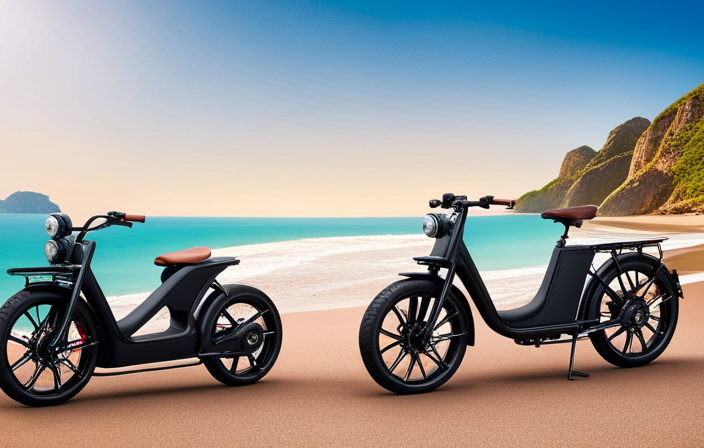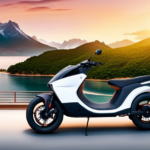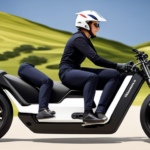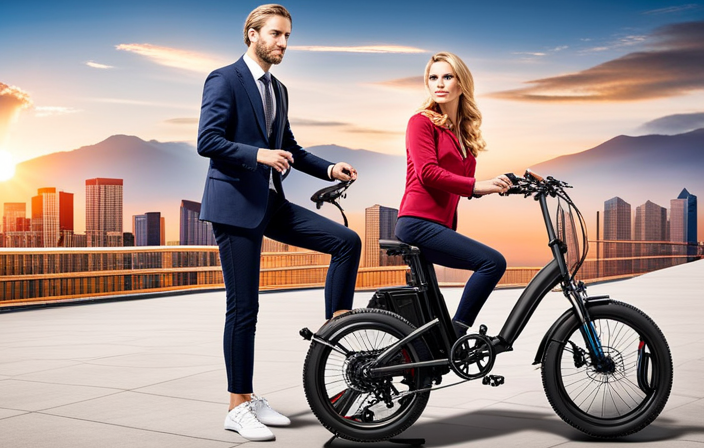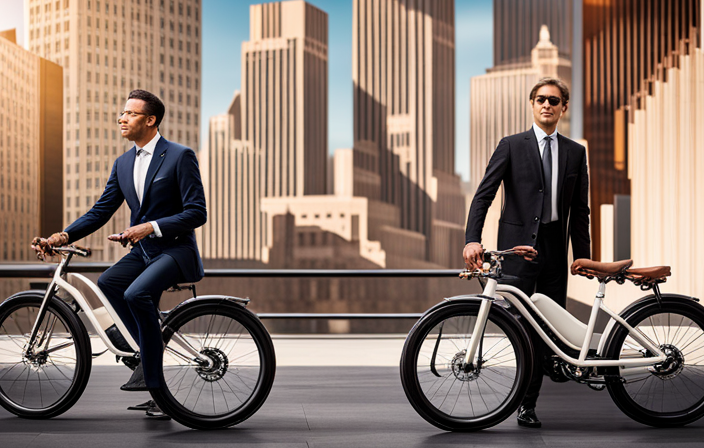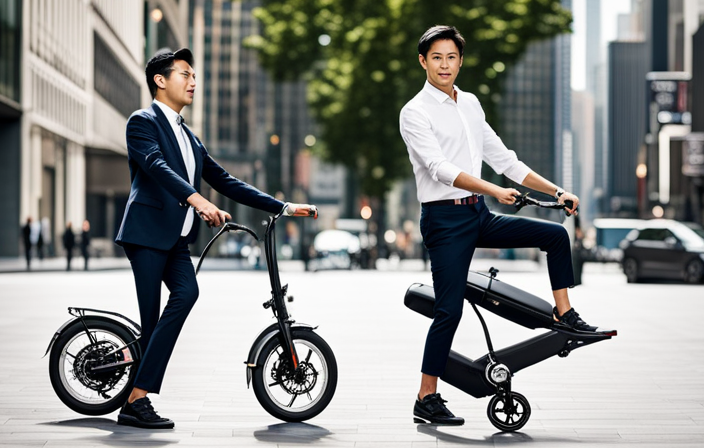Get ready to embark on an electrifying journey with your electric bike! Have you ever wondered just how far these amazing machines can take you? Brace yourself, because we’re about to dive into the world of electric bike mileage.
Prepare to be astonished as we explore the factors that influence the number of miles you can conquer on your electric bike. From battery capacity and terrain to riding style and maintenance, we’ll leave no stone unturned in our quest to uncover the answer to the age-old question: how many miles can an electric bike go?
Key Takeaways
- Factors that influence electric bike mileage include battery capacity, terrain, riding style, and maintenance.
- Understanding battery capacity and range is crucial for maximizing the lifespan of the battery.
- The type of e-bike system, whether pedal-assist or throttle-controlled, affects the mileage and usage of the battery.
- Terrain and elevation have a significant impact on the mileage of electric bikes, and factors such as tire pressure and rider weight should be considered.
The Basics of Electric Bikes
You’ll be amazed at how many miles an electric bike can take you! Electric bikes are revolutionizing the way we commute and explore. With their advanced technology and powerful motors, these bikes can go the distance.
One of the key factors that determine how far you can ride on an electric bike is the battery life. Modern electric bikes come equipped with high-capacity batteries that can last for miles on a single charge. Additionally, there are various charging options available, such as plugging it into a standard electric outlet or using a portable charger.
Understanding battery capacity and range is crucial in maximizing your electric bike’s potential. It’s important to note that factors like terrain, rider weight, and assist level can influence the total distance you can cover.
So get ready to embark on exciting adventures and explore new horizons with your electric bike! Now, let’s dive into understanding battery capacity and range.
Understanding Battery Capacity and Range
To understand battery capacity and range, you can gauge how far you can travel on your e-bike. This is determined by several factors, including battery charging techniques, battery lifespan, and degradation. Here’s what you need to know:
-
Battery charging techniques: It’s important to follow the manufacturer’s guidelines for charging your e-bike battery. This includes using the recommended charger and avoiding overcharging or undercharging the battery.
-
Battery lifespan: Like all batteries, e-bike batteries have a limited lifespan. However, with proper care and maintenance, you can maximize their longevity. Regularly checking and maintaining the battery, such as keeping it clean and storing it in a cool, dry place, can help extend its lifespan.
-
Battery degradation: Over time, e-bike batteries may experience degradation, which can result in a decrease in range. Factors such as temperature, usage patterns, and charging habits can affect the rate of degradation.
Understanding these aspects of battery capacity and range is crucial in making informed decisions about your e-bike. As we move into the next section about pedal-assist vs. throttle-controlled electric bikes, you’ll gain further insight into the different types of e-bike systems.
Pedal-Assist vs. Throttle-Controlled Electric Bikes
When choosing between a pedal-assist and throttle-controlled e-bike, it’s important to understand the differences in how the two types of systems operate.
A pedal-assist electric bike, also known as a pedelec, provides assistance to the rider’s pedaling motion. This means that when you pedal, the motor kicks in and provides additional power, making it easier to climb hills or ride for longer distances. The pedal-assist system offers several benefits, including a more natural riding experience, increased range, and improved fitness.
On the other hand, throttle-controlled e-bikes rely solely on the throttle to control the speed of the motor. While this system offers instant power and requires less effort, it can also drain the battery quickly and limit the range.
Transitioning to the next section about ‘terrain and elevation: how they impact mileage’, it’s important to consider how these factors can impact the performance of both pedal-assist and throttle-controlled e-bikes.
Terrain and Elevation: How They Impact Mileage
Navigating different types of terrain and dealing with changes in elevation can significantly affect the distance you can travel on your e-bike. When it comes to terrain, the effect of tire pressure cannot be ignored. Ensuring that your tires are properly inflated can make a big difference in your mileage. Riding on rough, unpaved roads can cause more resistance and reduce your overall range.
Additionally, the impact of rider weight should not be overlooked. Heavier riders may experience a decrease in mileage compared to lighter riders. Uphill climbs can also have a noticeable impact on your e-bike’s range. The motor has to work harder to overcome gravity, which can drain the battery faster.
As you navigate through different terrains and elevations, keep these factors in mind to maximize your e-bike’s mileage.
Moving on to the next section about riding style and speed: maximizing efficiency, it’s important to consider…
Riding Style and Speed: Maximizing Efficiency
Your riding style and speed greatly impact the efficiency of your e-bike. To maximize battery life and get the most out of each charge, it’s essential to adopt efficient riding techniques.
One key technique is to maintain a steady pace and avoid sudden accelerations or decelerations. Smooth and gradual transitions help conserve energy and extend your range.
Additionally, be mindful of your speed. Riding at a moderate pace allows the motor to work more efficiently and reduces strain on the battery.
Another tip is to use pedal-assist mode when possible, as it enables you to contribute to the power output and reduces reliance on the motor.
By implementing these strategies, you can maximize the mileage of your electric bike.
Now, let’s explore the effects of wind and temperature on your e-bike’s performance.
Weather Conditions: The Effects of Wind and Temperature
The effects of wind and temperature on an e-bike’s performance can significantly impact its efficiency.
When it comes to wind, riding against a strong headwind can dramatically decrease your electric bike’s mileage. The resistance created by the wind can make it harder for the motor to propel the bike forward, resulting in a shorter distance covered on a single charge.
Similarly, temperature can also affect the performance of your e-bike. In colder weather, the battery’s capacity may be reduced, causing it to drain faster and resulting in a shorter range. Conversely, in hotter temperatures, the battery may overheat, which can also lead to decreased performance.
Understanding these effects and taking them into consideration when planning your rides can help you optimize your e-bike’s efficiency.
Now, let’s delve into the next section about ‘weight and load: how much can an electric bike carry?’
Weight and Load: How Much Can an Electric Bike Carry?
Now that we’ve discussed the effects of wind and temperature on electric bike performance, let’s shift our focus to weight and load capacity. One of the great advantages of electric bikes is their ability to carry heavy loads, making them a practical option for transportation and errands. Electric bikes typically have a weight capacity ranging from 250 to 400 pounds, depending on the specific model. This means you can easily transport groceries, backpacks, or even larger items without straining the bike’s motor or frame. Additionally, many electric bikes offer cargo options such as racks, baskets, or panniers, allowing you to conveniently carry your belongings. With these weight capacity and cargo options, you can confidently embark on your daily activities without worrying about the strain on your electric bike. Speaking of maintenance and care, let’s explore how you can keep your electric bike running smoothly.
Maintenance and Care: Keeping Your Electric Bike Running Smoothly
To ensure your e-bike runs smoothly, it’s essential to regularly maintain and care for it. Proper maintenance can help prevent common issues and keep your electric bike in top shape. Here are some maintenance tips to keep in mind.
Firstly, regularly clean your e-bike to remove any dirt or debris that may have accumulated. Use a gentle detergent and a soft cloth to avoid scratching the frame.
Secondly, check the tire pressure regularly and inflate them to the recommended level. This will ensure a smooth and efficient ride.
Additionally, lubricate the chain and gears to reduce friction and extend their lifespan.
Lastly, if you encounter any issues, such as the motor not working or the battery draining quickly, consult the user manual or contact a professional for troubleshooting advice.
By following these maintenance tips, you can keep your electric bike running smoothly for years to come.
Now, let’s move on to some tips for extending your electric bike’s range without sacrificing performance.
Tips for Extending Electric Bike Range
If you want to get more out of your e-bike rides, here are some tips for maximizing your range.
One of the most important factors in extending battery life is managing your charging strategies. Avoid overcharging your battery by unplugging it as soon as it reaches 100%. It’s also a good idea to charge your e-bike after each ride, even if it’s not completely drained. This will help maintain the battery’s overall health and ensure a longer range.
Another tip is to pedal more and use the motor less. By pedaling, you’ll reduce the strain on the battery and extend your range. Additionally, try to ride on flatter terrains and avoid steep hills, as they can drain your battery quickly.
By following these tips, you’ll be able to extend your electric bike’s range and enjoy longer rides.
Now, let’s delve into some real-life examples of the longest electric bike journeys.
Real-Life Examples: Longest Electric Bike Journeys
One of the most impressive electric bike journeys was completed by a cyclist who traveled over 10,000 kilometers across Europe. This incredible feat not only showcases the potential of electric bikes but also highlights the growing popularity of long-distance electric bike travel.
The world of electric bike journeys is filled with amazing records and inspiring stories. From crossing continents to conquering rugged terrains, electric bike enthusiasts are pushing the boundaries of what is possible on two wheels.
The longest electric bike journeys have taken riders through diverse landscapes, from sprawling cities to remote mountain ranges. These journeys not only demonstrate the range and endurance of electric bikes but also showcase the beauty and freedom of exploring the world on two wheels.
Whether you’re an avid cyclist or simply curious about the capabilities of electric bikes, these real-life examples will surely leave you inspired and longing for your own epic adventure.
Frequently Asked Questions
Are there any regulations or restrictions on riding electric bikes?
Yes, there are regulations and restrictions on riding electric bikes. These vary by location, but commonly include speed limits, age restrictions, helmet requirements, and where they can be ridden. It’s important to familiarize yourself with local laws before riding.
How long does it take to charge an electric bike battery fully?
Charging an electric bike battery fully depends on the battery capacity and charger type, ranging from 2-8 hours. It’s crucial to consider battery lifespan, as frequent charging may affect its longevity. So, find the right balance to ensure optimal performance and longevity.
Can I ride an electric bike in the rain or through puddles?
Yes, you can ride an electric bike in wet conditions, including rain and through puddles. However, it’s important to practice proper maintenance for electric bikes to ensure their longevity and performance in these conditions.
What is the average lifespan of an electric bike battery?
The average lifespan of an electric bike battery is influenced by various factors. These include average battery capacity, usage patterns, charging habits, and environmental conditions. It’s like a journey, where each decision affects the length of the ride.
Are there any safety precautions I should take when riding an electric bike?
When riding an electric bike at night, it’s important to prioritize safety. Ensure you have proper lighting and reflectors, wear reflective clothing, and follow traffic laws. To maintain your battery, avoid extreme temperatures and charge it regularly.
Conclusion
In conclusion, now that you’ve learned about the basics of electric bikes, understanding battery capacity and range, and the impact of terrain and elevation, you’re well-equipped to maximize the mileage of your electric bike.
By considering factors such as riding style and speed, weight and load, and proper maintenance and care, you can ensure that your electric bike runs smoothly and efficiently.
Follow these tips and embark on your own electric bike journey, just like those who have achieved the longest rides on their electric bikes.
Happy riding!
